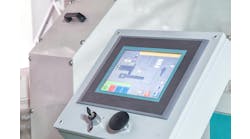Dan Hebert is a former senior technical editor for Control, Control Design and Industrial Networking.
A combo controller and operator interface can save big compared to separates.
As the miniaturization of electronics continues its relentless march across the personal-consumer-device landscape, it's only natural for it to proceed apace in machine and robot automation systems. One consequence is the combination of what were once separate components into a single housing, as with a machine controller and an operator interface device.
Although relatively new on the scene, these combo units have seen significant adoption by machine builders because they are less expensive than separates, require no wiring or integration between the controller and the operator interface, and take up less panel space.
For many applications, these benefits more than negate disadvantages, which include a single point of failure for both control and operator interface and a lack of the highest-end functionality, particularly for basic units.
These combo units come in two main flavors. The first combines a PLC with an operator interface terminal (OIT) to create a unit designed for basic machines. The second marries a PC-based controller to a full-featured HMI, creating a unit capable of providing control and operator interface for the most complex machines.
Combo PLC-OIT units were initially introduced with limited features and functions, but more recent products have upped the ante by adding more sophisticated capabilities. "The newest addition to our FT1A Touch micro programmable controller series of combo HMI+PLC units is the FT1A Touch 14 I/O, with new features making it suitable for advanced analog monitoring and control," says Don Pham, a product manager at IDEC.
"The FT1A Touch 14 I/O provides up to 158 discrete and analog inputs and outputs, using FT1A controllers as remote I/O slaves, PID control, Ethernet communications and a built-in 3.8-in touchscreen HMI in a compact package costing less than $500," adds Pham.
This is obviously an attractive price point, one hard to match by purchasing a separate PLC and an OIT, particularly when the cost of wiring, integrating and installing two separate units is taken into account.
A bit higher up the scale in price and performance, staring at about $1,000, is the Perspecto CP TV line of combo units from Wago. These units feature five sizes of TFT touchscreens: 3.5, 5.7, 10.4, 12.1 and 15 in. "Performance is optimized with scaled processing power up to 1.6 GHz processor, 256 MB of RAM and 128 MB of Flash memory," notes Charlie Norz, the product manager for WAGO I/O Systems.
"Our combo units are programmed using CoDeSys software, providing advanced programming tools, support for all the IEC 61131-3 programming languages and an easy-to-use graphic editor," notes Norz. These units also have multiple interface ports, including CAN bus and Ethernet, and a built-in Web server that allows remote users to view and control the graphic screens using any browser.
These combo units can be a good fit for machine builders not requiring large HMI-type screens, hundreds of I/O points or advanced control functionality. For applications requiring those features and functions, the next step up the line are combo PC+HMI units.
Readers over 40 years old may have not-so-fond memories of the sheer size, bulk and weight of older PC-based control systems. Not only was the CRT-based screen a monster, so was the industrial PC. Add, in some outboard I/O, the entire package was cost- and size-prohibitive for all but the most high-end applications.
See Also: Interface Interference in the Machine Operating World
But times have changed, and new units simply tack a PC-based controller onto the back of a flat-panel screen, creating a slim panel-mount package with reasonable weight and not much more depth than a monitor alone.
A pioneer in this area is Beckhoff Automation with its panel PCs. "Rather than recommending a multi-component solution with separate PLC and HMI hardware, we offer customers an all-in-one approach combining an industrial PC and HMI, packaged as a streamlined panel PC," explains Reid Beilke, the industrial PC product specialist at Beckhoff.
"These units offer multicore processing performance, available multi-touch functionality and customizable housings. When running our TwinCAT software, one multi-tasking panel PC can handle the work of multiple PLCs, while also performing motion and robotic control," adds Beilke.





